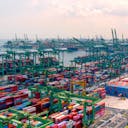Paris and Amsterdam, November 17, 2020
BIC (Bureau International des Containers) and DCSA (Digital Container Shipping Association) today announced completion of their collaboration to standardize the codes used to identify facilities such as depots, container yards, M&R vendors and other supply chain container facilities. Thanks to the active participation by DCSA member ocean carriers as well as several of the largest leasing companies, the organizations have achieved a clean, machine-readable database of over 11,000 facilities in 160 countries. Each facility in the database now has a structured address, GPS coordinates and a 9-character BIC Facility Code assigned to it that can be easily consumed by existing IT systems to facilitate adoption.Machine learning techniques were used to sanitize and align nearly 30,000 facility codes from 10 major carriers and lessors, resulting in high-quality, harmonized facility names, addresses, GPS coordinates, and the standardized code the industry was looking for. DCSA Track & Trace standards, for example, now refer to the BIC Facility Code to identify places for supply chain events without ambiguity.The API, currently available on SwaggerHub, will enable supply chain participants to ensure their systems are utilizing a unique, standardized code for every container facility. Those wishing to host their own version can subscribe to automatic synchronous updates to ensure they are always up to date. In addition, the API serves both the BIC Facility Code and the SMDG Ocean Terminal code lists, meaning the industry can access a one-stop API for the 11,000+ BIC Facility Codes and 900+ SMDG Ocean Terminal Codes.The BIC Facility Code, or “Locode”, was originally developed under international standard ISO 9897, assigned to the BIC in 1997 and is now a listed “child code” of the UN/Locode. Adoption of the harmonized codes is expected to result in smoother communication between parties, quicker identification of facilities by third parties such as motor carriers and telematics providers, more efficient lessor-leasee communications related to on/off-hires, and better visibility for BCOs. Looking ahead, geo-features (geo-fencing coordinates) are planned, which will make the database even more valuable for operators of smart containers or assets looking to automatically confirm the facility in which a container is located, or to enable location-based automation.“Over the last few years our industry’s data silo mentality has rapidly given way to a new appreciation of standardization and the efficient sharing of data. This new focus has allowed us to conduct a global facility code harmonization we have long wished to complete, thanks in large part to the DCSA’s assistance in actively engaging the major carriers. Moreover, the participants are eager to embrace the API, which will ensure the harmonized codes are widely available and in sync going forward. We see this as an important enabler for digitalization efforts underway in the industry,” said Douglas Owen, Secretary General of the BIC.“At the outset of DCSA, our Chairman André Simha pointed to the non-standard facility code as a simple yet effective example of the kind of standardization where the industry needs to play catch up with other industries, such as air travel, which utilizes a standard airport code worldwide,” said Thomas Bagge, CEO DCSA. “With the standardization of the BIC Facility Code and the API, the container transportation industry is one step closer to this goal. This is a good example of the foundational work required to make digital transformation a reality in container shipping, and we are pleased to be a part of this important collaboration with BIC.”To learn more about the BIC Facility Code API or to consult it online, visit www.bic-code.org
Digitalise the container shipping industry
At DCSA, we envisage a digitally interconnected container shipping industry in which customers have a choice of seamless, easy-to-use services that provide the flexibility to meet their business and sustainability goals.









